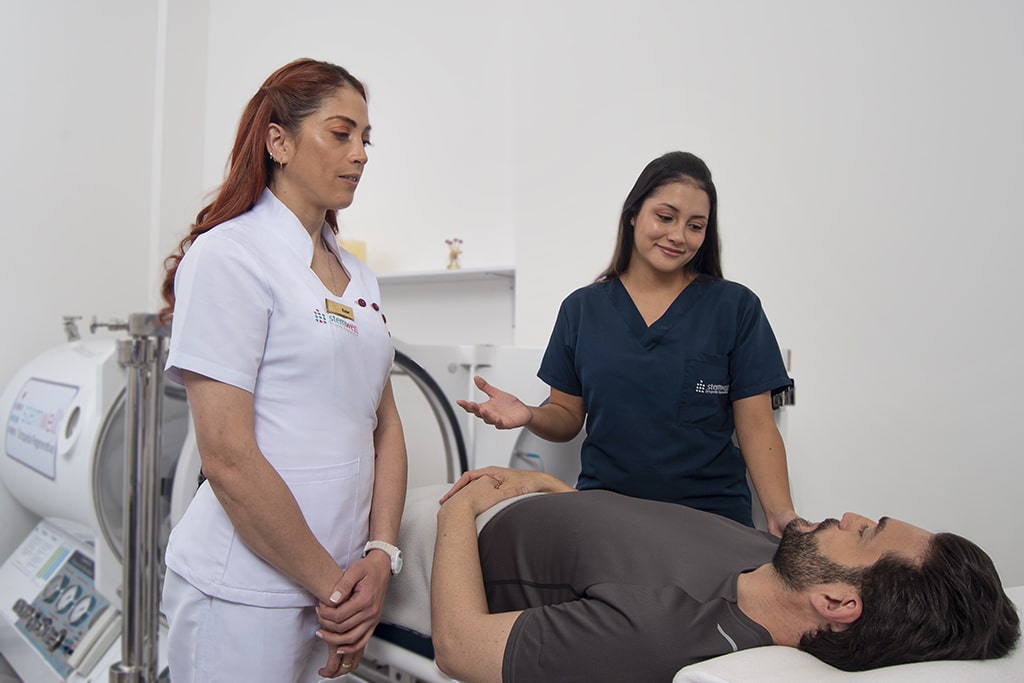In recent years, the field of regenerative medicine has seen remarkable advancements, with stem cell therapy at its forefront. The innovative treatment has the potential to revolutionize how we approach chronic disease, injuries, and age-related conditions.
But how ‘successful’ are stem cell therapies proving to be? In this blog, we will explore what impacts the success of stem cell therapy and examine the effectiveness of these treatments.

What is stem cell therapy?

Stem cells are blank (undifferentiated) cells that can specialize into a wide range of cells that the body needs. This makes them powerful tools in regenerative medicine.
When injected into the body or targeted region during therapy, stem cells can specialize into the cells needed to promote the healing of a certain region. For example, stem cells might develop into cartilage tissue to help heal an injury.
These stem cells then divide exponentially and stimulate the body’s own healing process.
As well as tissue regeneration and repair, stem cells can also help to modulate the immune response and reduce inflammation in the body.
Together, these unique properties mean that stem cell therapy has the power to support the healing of a wide range of medical conditions. Stem cell therapy is becoming increasingly popular, but it is still considered a relatively experimental approach with ongoing research.
How is ‘success’ defined in stem cell therapy?
In the context of stem cell therapy, ‘success’ refers to the proportion of patients who achieve the desired therapeutic outcome after treatment. This can include criteria such as a reduction in symptoms, improvements in standard health metrics, and overall quality of life enhancements. Success is often evaluated through a variety of measures, including:
- Laboratory assessments (like blood examinations)
- Clinical outcomes (using various diagnostic tools such as scans or physical examinations)
- Patient outcomes (such as quality of life and symptom measures).
Factors impacting success rate
The stem cell therapy success rate can vary greatly between individuals. A wide range of factors can influence how successful treatment might be:
Patient condition
Some conditions may respond better to stem cell therapy than others. The severity of the disease or illness can also influence overall success and the extent of recovery.
Patient health
Healthier patients often experience better outcomes due to their body’s inherent ability to recover and regenerate.
Aftercare
Patients who continue with rehabilitation and follow recovery protocols after stem cell therapy are more likely to experience longer benefits of the treatment.
Source of stem cells
Stem cells can come from various bodily tissues. The origin of the stem cells can significantly impact the therapeutic outcome, and each source has a wide range of pros and cons. At Stemwell, we use stem cells derived from umbilical cord tissues of healthy donors. We believe (and evidence shows) that these cells offer one of the richest sources of mesenchymal stem cells – a powerful undifferentiated stem cell – and can be ethically collected.
Processing of stem cells
How stem cells are harvested, processed, stored, and administered can significantly affect their therapeutic potential. At Stemwell, our expert team follows rigorous steps to carefully collect and analyze stem cells in a safe and non-invasive way.
Research showing success rates of stem cell therapy

As there are so many factors which can influence the success rate of stem cell therapy, and there is limited research available on the topic, it’s not possible to give an overall average success rate of the treatment. However, existing studies can give an insight into how successful stem cell therapy can be in certain instances.
For example, mesenchymal stem cell therapy for orthopedic and musculoskeletal injuries (such as tendon injuries and cartilage defects) has supported the healing of many patients. These injuries are often the result of injuries or conditions such as osteoarthritis. A review of stem cell therapy in osteoarthritis found that although success rate varied depending on the severity of the injury and other factors, many patients experienced improvements such as better joint functioning, reduced pain levels, and improved quality of life.
Autoimmune conditions like multiple sclerosis (MS), Crohn’s disease, and rheumatoid arthritis have also been targets for stem cell therapy due to its anti-inflammatory and immunomodulatory (ability to regulate and improve immune system functioning) potential. For example, a meta-analysis and systematic review of mesenchymal stem cell therapy in patients with MS found that just over 40% of patients showed improvements in their condition.
Stem cell therapy has also been applied to other conditions such as neurological conditions, chronic pain, and spinal cord injuries.
Research shows varying degrees of effectiveness across conditions, and the stem cell therapy success rate often hinges on a wide range of factors stated above.
What happens if stem cell therapy is not successful?
As much as we do everything to boost the chances of stem cell therapy being successful, sometimes it does not provide the result that an individual is hoping for. While this is disappointing, there are often alternative treatment options.
Complementary therapies (alongside stem cell therapy) or alternative therapies may provide further treatment options. These treatments could include traditional medical interventions, physical therapy, or other regenerative medicine approaches depending on the individual’s response and medical needs.
Frequently asked questions
Stem cells can either be administered intravenously (through the bloodstream) or via a direct injection to the targeted area. Some patients may have both.
The timeline of the most noticeable results can vary widely between patients. Usually, most people see the biggest change between 3 and 6 months after stem cell treatment, but some people may notice changes before this time. Following aftercare protocols will help to promote healing and support your recovery.
The total cost depends on many individual factors. At Stemwell, we will take you through a full health consultation and develop a bespoke treatment plan based on your needs. After this process, we will be able to give you an indication of the total cost.
Stem cell therapy is still considered an experimental approach, and not enough research has been done to understand the long-term safety and effectiveness of the treatment.
Early studies have shown that mesenchymal stem cell therapy is generally low risk, and there is no chance of rejection from the body. Our experienced team also undertakes a rigorous analysis process to screen the cells for their safety. In Bogota, where we are based, stem cell therapies are also regulated by the Secretary of Health. We always remain within health system regulations and ensure all treatments are extensively tested.
However, like any medical procedure, there is always a risk of side effects and each individual responds to stem cell therapy differently. At Stemwell, our team is highly knowledgeable and will be able to answer questions about your individual risk and treatment.
Our advanced facility is located within a fully certified and accredited hospital in Bogota, Colombia.
Unless a doctor wants to keep you in for observation, you should be able to return home overnight between treatment days. We try to make our procedures as convenient as possible.
There have been some ethical concerns around the use of embryonic stem cells – which are derived from embryos. While these stem cells are seen as extremely versatile, they raise ethical concerns because using them in stem cell therapy requires destroying the embryo.
Find out more by speaking with Stemwell today

Find out more about how stem cell therapy may be able to help you by contacting us or apply today to check your eligibility.

